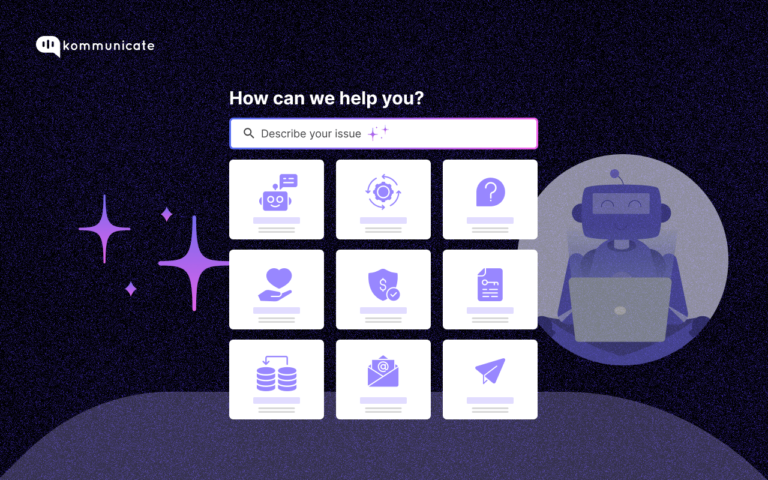Updated on March 1, 2024
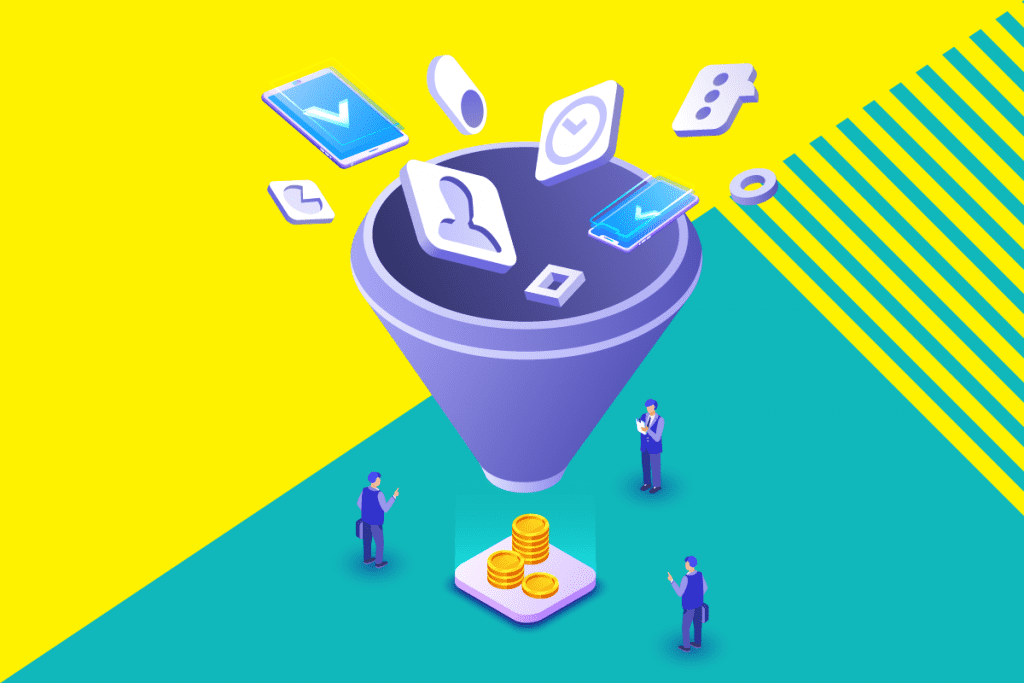
How To Build a Strong Sales Pipeline
To know the importance of a Sales pipeline, always remember what the Canadian-American author and motivational speaker, Brian Tracy, said:
“Keep your sales pipeline full by prospecting continuously. Always have more people to see than you have time to see them.”
While Mr. Tracy was right about prospecting, there are a few other methods you could use to build a strong sales pipeline, and, in this blog post, we explore some of these methods.
In this article, we will cover:
- Sales pipeline process
- What is the sales pipeline?
- How to build a sales pipeline?
- What are the top mistakes to avoid while building a sales pipeline
- Top metrics to determine the health of a sales pipeline
Sales pipeline process
To begin with, let us first understand the process and stages first.
We all know that sales is a continuous process and it is highly dependent on maintaining an engaging relationship with your prospects. Closing new deals and ensuring maximum repeat purchases requires maintaining a healthy process of delivery and expectations management.
So, here is a closer look at the various stages in a sales funnel. This highlights all the sales pipeline stages, and analyzing each step can help you to improve your sales pipeline, closure rate, and repeat purchases with time.
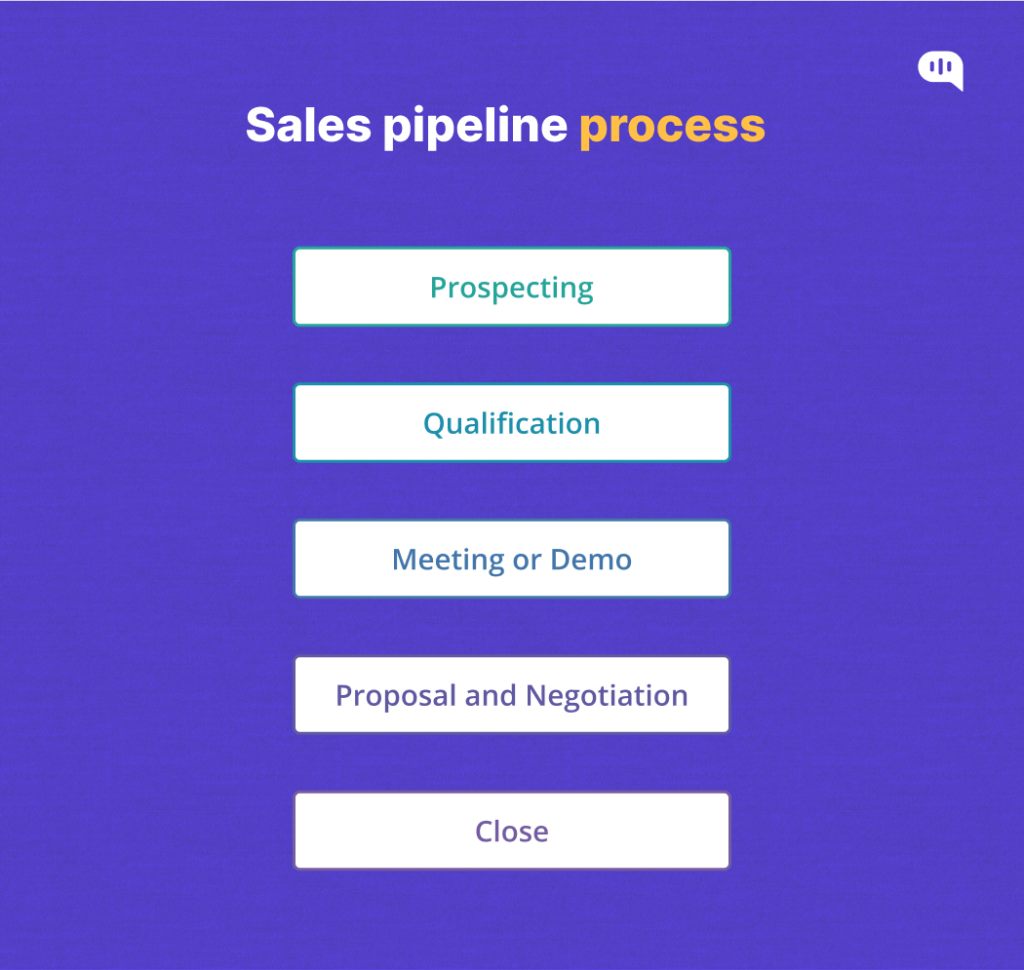
In the diagram above, you can see that stage 01 and Stage 02 are the phases in which a lead is qualified. As soon as the need is identified, the lead becomes a part of the pipeline with an approximate expected date of purchase.
Today, you can easily manage all these details using CRMs which act as a sales pipeline management software for both new and existing customers.
What is a sales pipeline?
Sales Pipeline is the list of opportunities with an identified need for the product based on concrete actions. It is generally represented visually in the CRM (if leads are in Stage 03 and Stage 04 as per the diagram above) as a part of the sales funnel. Stages of representation may vary from company to company and sometimes even product to product.
You must ensure that your sales pipeline journey is well crafted and customized for maximum closure rates.
While we understand the stages now, and you must have thought about the process as per your organization, the next question that arises is, what are the best practices to manage and build the same?
Sales Funnel Vs. Sales Pipeline
While the sales pipeline and sales funnel seem similar, they are used interchangeably, which is inaccurate. The sales funnel displays the buyer’s journey through the process of the sale. The sales pipeline, on the other hand, covers the effort that is required from the side of the salesperson to close the sale from start to finish.
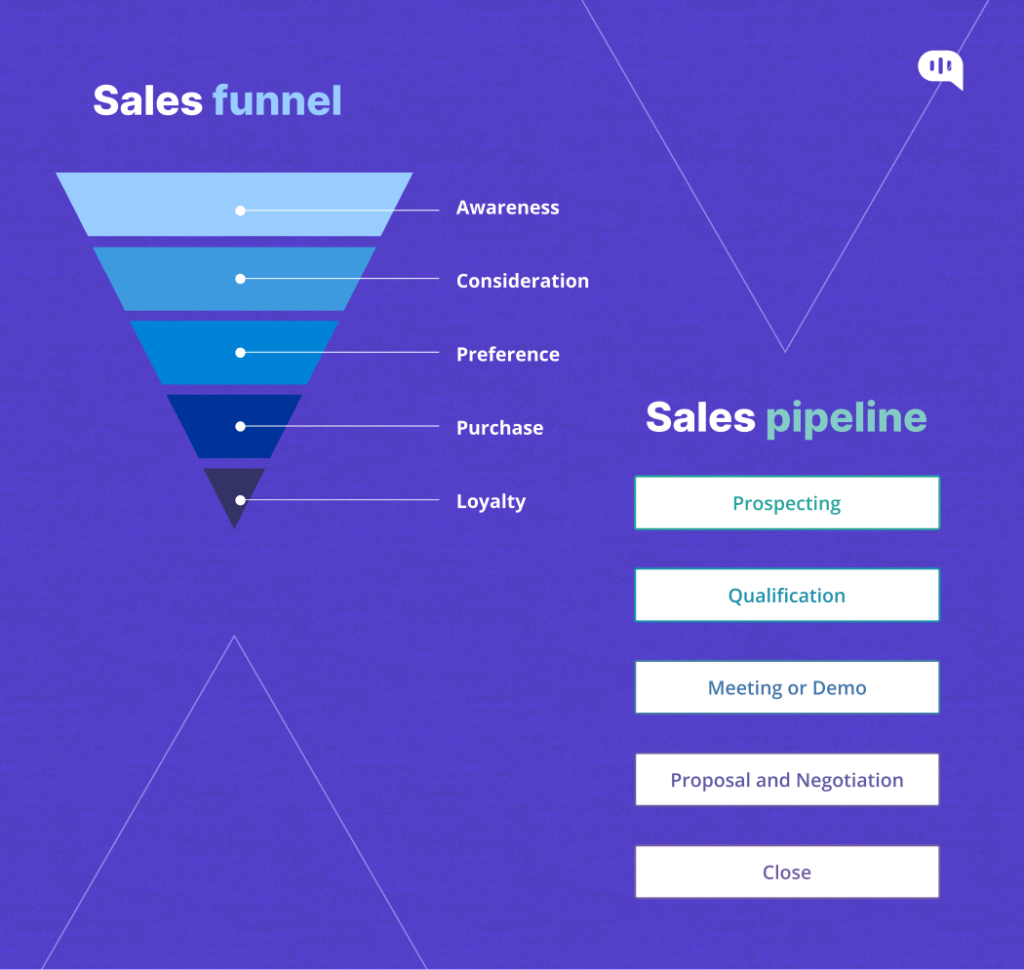
While the sales pipeline includes deals, a sales funnel has to do with leads. A sales pipeline is every step a sales representative undertakes to progress a deal from start to finish. On the flip side of this, a sales funnel includes the various phases in the buyer journey that a sales representative’s leads go through before they turn into customers.
How to build a Strong Sales Pipeline:
1. Identify Your Target Market:
Start by pinpointing who you want to target and why. What industry do they belong to? What is their ideal customer profile?
a. Geographic: Where is your target market located?
b. Demographic: What is the age, gender, race, and income level of your target market?
c. Psychographics: What are the interests, attitudes, values, and lifestyles of your target market?
d. Behavioral: What behaviors and habits drive the purchasing decisions of your target market?
2. Define a Sales Process:
Create a step-by-step process that outlines how a customer moves through the sales cycle. This should include stages such as prospecting, qualification, pricing, and closing.
- Lead Identification: Identifying leads by researching potential customers and using customer personas.
- .Lead Qualification: Analyzing customer needs and assessing their viability as a customer of your SaaS product.
- Initial Contact: Reaching out to leads via email, phone, or other channels to introduce them to your product and determine if they are interested.
- .Product Demonstration: Providing prospects with a demonstration of the product and how it can meet their needs.
- Pricing Negotiation: Discussing pricing options and negotiating terms that work for both parties.
- Proposal: Creating a customized proposal for the prospect.
- Contract Negotiation: Reviewing contracts and negotiating any changes before signing to ensure both parties understand the agreement.
- Onboarding: Helping the customer implement the product and going over customer support processes.
i . Follow Up: Following up with customers to ensure they are getting the most out of the product and answering any questions.
3. Develop Qualified Leads:
Discover lead generation tactics that will help you find prospects who are likely to convert. This can include using PPC campaigns, going to trade shows, networking, and referrals from existing customers.
As a sales professional, understanding and utilizing the best tools in the market can significantly streamline your prospecting efforts. Exploring the top sales prospecting tools reviewed can provide you with insights into efficient strategies and tools that refine your sales pipeline process, enhancing productivity and ultimately, sales outcomes.
a. Utilize social media to create content that resonates with your target audience, such as blog posts and videos, and use ads to target them.
b. Research industry events and tradeshows and attend as a vendor or speaker.
c. Leverage existing client relationships by networking and asking for referrals.
d. Leverage online directories and review websites to build up credibility and visibility.
e. Partner with other businesses to share leads.
f. Use cold calling and email outreach campaigns to target qualified leads.
g. Use unique incentives, such as free products or services, to entice prospects.
h. Use marketing automation to nurture leads through the sales process.
i. Monitor competitors to stay on top of their activities.
j. Analyze sales data to inform decisions and identify potential areas of improvement.
4. Establish an Effective Follow-up Strategy:
Decide what method of communication you will use for follow-up (e.g. email, phone, etc.). This can help you keep in touch with your leads on a regular basis and maximize the chances of converting them.
5. Utilize Automation Software:
Invest in software that will automate mundane tasks such as outreach emails, scheduling meetings, and tracking sales performance.
6. Host Webinars/Events:
This can be a great way to engage potential customers and show them how your SaaS product can solve their problems.
7. Offer Free Trials:
Offering a free trial to qualified leads can be a great way to encourage them to give your product a try.
8. Gather Feedback:
Gathering feedback from customers throughout the sales process can help you gain insights into what works and what doesn’t. This information can help you improve the sales funnel and increase conversions.
While these are the best practices, some top mistakes are often repeated.
Top mistakes to avoid while building a sales pipeline
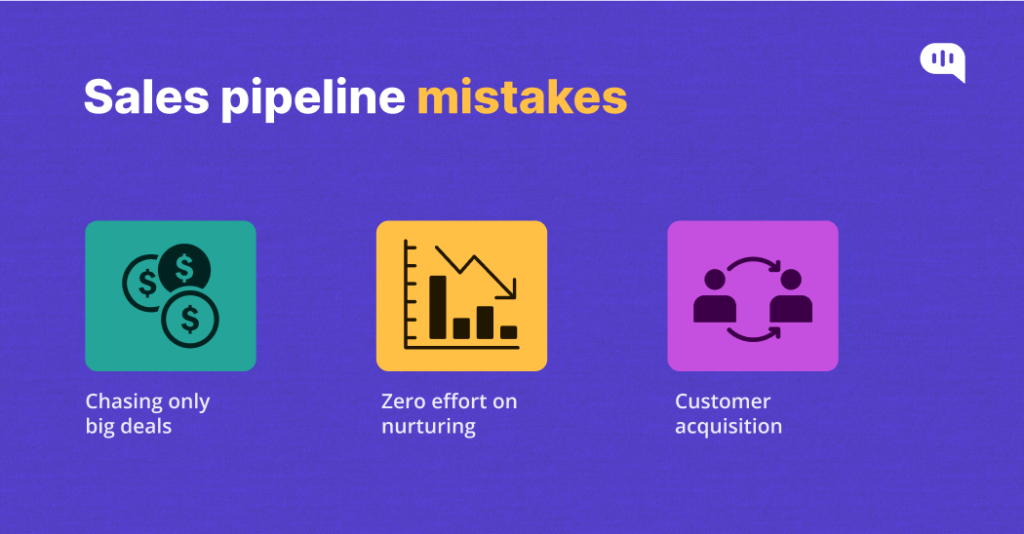
- Chasing only the big deals. We often run after the high value, but we forget that such deals are time-consuming, and we can’t miss smaller deals. Create a trade-off process to ensure you have a minimal loss.
- Zero effort on nurturing can be fatal. Right at the onset, we highlighted that sales are a lot of relationships and not just about products. A good effort must be put forward to nurture prospects.
- Using customers effectively is a great way to keep the pipeline healthy. Customers must be used as an asset for growth, and a good amount of effort is gone in retention rather than just acquisition.
Wow! By now, you must have decided what to do and what not to do, but how you will continuously improve may pose a big challenge as you grow. To avoid that, the growth metrics must be well defined right from the onset.
Top metrics to determine the health of a sales pipeline
Here are the top metrics that must be analyzed to measure the health of your sales pipeline.
1. Number of deals in pipeline
According to most CRM software and sales professionals, a deal is used to explain an opportunity to sell your company’s products and services. Visibility into the number of deals that the sales team in a company are pursuing is essential to gauge the health of a sales pipeline. Deals are qualified opportunities in the sales pipeline.
2. Average deal value
While each lead has the potential to bring an amount of business, the deal value is always in flux. By the time the lead transforms into a customer, the amount of business it brings in may fluctuate, but having an approximate deal value that is expected will help predict revenue.
It is best to widen your search beyond just the biggest deals and direct your attention toward how interested your prospect is in your product or service and is accordingly willing to invest. You can also close a set of small deals that can frequently convert into one massive deal.
The average deal value is the ratio of the total value of all the deals scored to the number of deals scored.
3. Average win rate
While sales representatives find many opportunities to feed the sales funnel, it is important to note how many of these sales opportunities convert into a sale. Monitoring the average win rate among all sales opportunities in the sales pipeline will help you measure conversions.
You can use the average win rate metric to enhance a sales representative’s performance by offering them different approaches that lead to conversions.
The average win rate can be defined as the ratio of qualified leads to sales opportunities.
4. Conversion rate or lead to opportunity ratio
Regardless of the sales opportunities that are secured or lost, it is important to note the process the sales team follows to convert the respective opportunities into leads. The opportunity conversion rate is a valuable metric to gauge the sales representative’s performance and the sales pipeline’s health. Your sales representatives might have their goals centered on bringing new leads with a low conversion rate into the pipeline. Such a scenario might still mean that the sales representative has a lot of potentially valuable deals in the sales pipeline.
The lead to opportunity ratio is the ratio of closed deals to the total number of deals in the pipeline. You can consider this metric as a long-term way to measure pipeline health.
5. Sales cycle length
The complete amount of time it takes to move a lead from the initial contact stage to the product’s actual sale is called the sales cycle length. The length will depend on the phases in the company for sales, such as sales prospecting, lead nurturing, and more. You can consider the complexity of the product or service sold to be a major factor in the sales cycle and deal sizes.
Sales cycle length also depends on the number of decision-makers and processes that are present in each company in the case of B2B sales. You will also need to consider the size of the company in B2B sales.
6. Pipeline value
When you need a relatively simple metric to measure the health of the sales pipeline, you can use the pipeline value. The pipeline value refers to the total number of deals in the sales pipeline.
One must continuously measure the average value and number of deals and compare it with his past records to determine if all is well.
Also, knowing that sales velocity is gradually decreasing can be considered a way to determine the effectiveness of all kinds of engagement activities and prospecting quality.
We hope you are now equipped to master your sales pipeline and drive wonderful results for your business.
Mastering this process can be a great way to detect any new entrant, attack by a competitor, or shift in the customer’s mind. A strong sales process is often considered the best way to be future-proof.
At Kommunicate, we are envisioning a world-beating customer support solution to empower the new era of customer support. We would love to have you on board to have a first-hand experience of Kommunicate. You can signup here and start delighting your customers right away.


